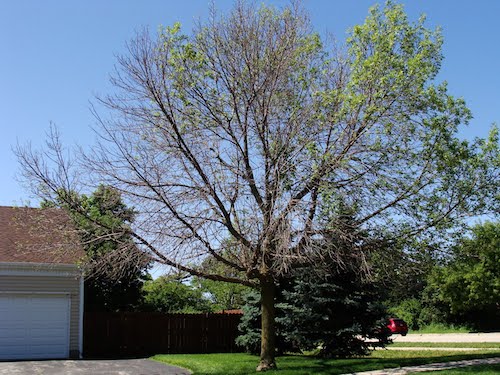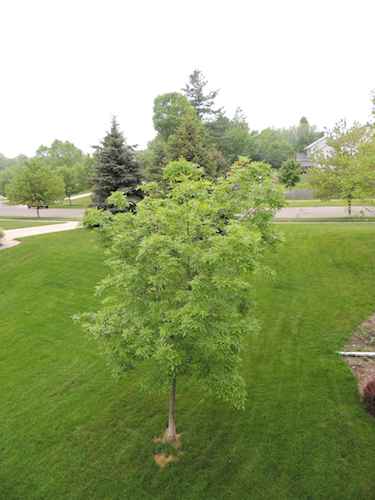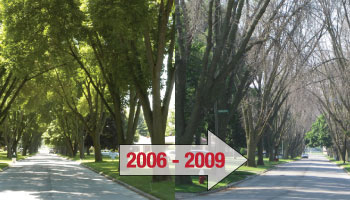Dealing with the Emerald Ash Borer, Page 2
The emerald ash borer invasion is considered by experts to be the most destructive forest pest in North America. Ever. Local, state, and federal governments have established quarantine zones and education programs to inform citizens of the risk to trees. They're also spending millions of dollars removing and destroying infected ash trees, leaving once-shady city streets devoid of any tree cover. Scientists at leading universities are working around the clock to find a solution to the emerald ash borer infestations, but with little success to this point.
But, that doesn't mean that as a property owner there aren't some things you can do to protect your trees.
Emerald Ash Borer: Solutions for Ash Tree Owners
Many homeowners have small numbers of ash trees on their property, as they boost home value and provide benfits such as the cooling effect of their shade on a home. If you've got an ash tree or two on your property, should you cut your losses and remove them now, or are there ways to protect them from the emerald ash borer onslaught? Research has led to a bit of optimistic news.
Insecticide Options for Emerald Ash Borer
A consortium of universities studying the EAB have come up with some insecticide solutions for ash trees that appear to ward off the emerald ash borer beetle and larvae. This has given hope to owners of ash trees in landscaped areas and yards that their cherished trees may be preserved.
These insecticide solutions are too costly and labor-intensive for use on large numbers of ash trees (such as wild tree populations), but appear to work for individual trees.
These insecticide solutions involve a couple of insecticides that have been tried and tested in various field studies. They involve injection treatments or pouring an insecticide solution on the soil around the trees' base.
These treatments can be applied by individuals, or by trained professional landscape contractors. The active ingredient in the products that work best are Imidacloprid, Dinotefuran, Azadirachtin,and Emamectin benzoate. These are found in products available to professionals under the names Merit, Safari, Transect, Xytect, Azasol, TreeAzin, and others.
For homeowners, look for products containing imidacloprid or dinotefuran under the names Bayer Advanced Tree & Shrub Insect Control, Optrol, and Ortho Tree and Shrub Insect Control Ready to Use.
All of these products work systematically in the tree, entering through the roots and moving up through the entire tree. These systemic treatments work best, though professionals do have several products at their disposal that can be applied directly to foliage in several steps.
It's important to note that if you begin treating an ash tree, you can't stop. These insecticidal treatments must be applied on a regular basis, as directed, probably for as long as you wish the tree to survive. If treatment is stopped, the tree will eventually become susceptible once again to the emerald ash borer. Keep this in mind when deciding whether or not to treat a tree. The treatments, and their costs, will be ongoing.
* A personal anecdote: I have been treating this young ash tree (pictured above) successfully with Bayer Advanced Tree & Shrub Insect Control for several years in Michigan, right in the middle of an EAB infestation. So far, the tree looks healthy and continues to grow.
When to Treat Ash Trees
Timing is important when treating ash trees with insecticides. These types of treatments deal with two different stages of EAB development, the larval stage and the adult stage. The system treatments need to be applied in time to allow the insecticide to work its way up through the trunk system in order for the EAB larvae to take in the poison. The product you use will identify the best times to apply. To treat the larval stage, application usually is recommended for sometime in April.
For the adult stage, product is applied directly to the leaves to keep the adult beetles. Adults emerge in May and June, so application after that is recommended. Thorough application is necessary to kill all beetles. Again, the systemic treatment option is the one most commonly used, and recommended.
To Treat Ash Tree, or Not To Treat
The decision to treat ash trees to prevent emerald ash borer damage is a personal one. If you have any ash trees you wish to keep around, you should start treating it immediately. Keeping EAB away from a healthy ash tree is the best plan of attack, since even a healthy-looking tree may already have the insect starting to work on it. The earlier you can get to it, the less chance of extensive damage.
If your ash trees are within 10 to 15 miles of a known infestation outbreak, they are definitely at risk. If you live in areas that are more than 15 miles from a known outbreak, you can wait to begin treatment.
If you have an ash tree that's already showing early signs of emerald ash borer infestation, you may still treat it in an attempt to save it. Treatments at this point may save the tree, but will not bring back any damaged parts of the tree.
Basically, all ash trees are at risk. Keep informed of updated quarantine zones and treatment recommendations by visiting http://www.emeraldashborer.info/ . Up-to-date treatment recommendations (June 2014) are available HERE.
Don't Move Firewood!
Whether you own ash trees or not, and whether you choose to treat them or not, the damage being wrought by the emerald ash borer affects us all. The biggest thing any individual can do is NOT move firewood, of any kind, from one area to another. All firewood should be used in the area in which it was cut. Until a solution is found that will treat emerald ash borer on a large scale, keeping them from spreading as much as possible is our best option.
Ash Tree Alternatives
If you've already lost an ash tree to emerald ash borer and want to replace it, there are some beautiful alternative tree species available. These include the autumn blaze maple, trident maple, hedge maple, norway maple, horse chestnut, American hornbeam, tulip tree, hackberry, gingko, and sawtooth oak.
Return to Page One
comments powered by Disqus






































































